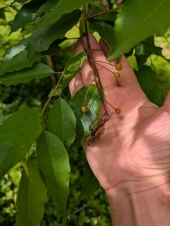
 2
2




 2
2




--------------------
Be Content. And work for more time, not money. Money is inconsequential.

 2
2




Be joyful, though you have considered all the facts. ~Wendell Berry
 6
6




I make a Maple Syrup instructional movie! Check it out HERE
SKIP books, get 'em while they're hot!!! Skills to Inherit Property
See me in a movie building a massive wood staircase:Low Tech Lab Movie
 3
3





 3
3




- Tim's Homestead Journal - Purchase a copy of Building a Better World in Your Backyard - Purchase 6 Decks of Permaculture Cards -
- Purchase 12x Decks of Permaculture Cards - Purchase a copy of the SKIP Book - Purchase 12x copies of Building a Better World in your Backyard
 4
4




 3
3




Preventative: Check the mulch, potting soil, compost, and any potted plants you bring home for worms. If you identify jumping worms, immediately bag up the material and dispose of it. You don’t want to put any of it in your garden!! Remove soil from all plants before transporting them or potting into sterile potting soil. This helps to remove jumping worm cocoons (egg cases). PLAY, CLEAN, GO: Leave no trace and clean equipment (gardening, hiking, etc.) before going to another location.
Invasive plants are Earth's way of insisting we notice her medicines. Stephen Herrod Buhner
Everyone learns what works by learning what doesn't work. Stephen Herrod Buhner












 5
5




- Tim's Homestead Journal - Purchase a copy of Building a Better World in Your Backyard - Purchase 6 Decks of Permaculture Cards -
- Purchase 12x Decks of Permaculture Cards - Purchase a copy of the SKIP Book - Purchase 12x copies of Building a Better World in your Backyard
 10
10
















 7
7




- Tim's Homestead Journal - Purchase a copy of Building a Better World in Your Backyard - Purchase 6 Decks of Permaculture Cards -
- Purchase 12x Decks of Permaculture Cards - Purchase a copy of the SKIP Book - Purchase 12x copies of Building a Better World in your Backyard
 3
3





 2
2





 4
4




 3
3




Life on a farm is a school of patience; you can't hurry the crops or make an ox in two days.
Henri Alain
 2
2




 2
2




Zone 6, 45 inches precipitation, hard clay soil




 5
5




Kim Goodwin wrote:Earthworms also were brought from the Old World to the Americas. So the soils here did not have them when the Europeans arrived.
I think Ben makes some good points. It sounds like these worms have all become part of the soil decomposition system.




 4
4
 1
1




Clay, shade, neighbor’s Norway maples.....we’ll work it out.








Debbie Ann wrote:I just saw these on the news. They said they are already in 37 states. They ruin and deplete your soil! Have any of you come across them? This website from the University of Maryland explained a lot. https://extension.umd.edu/resource/invasive-jumping-worms
Why am I always the last one to learn something?

 2
2





| I agree. Here's the link: http://stoves2.com |

